Abstract
Assessing the landscape health of suburban forest parks is a prerequisite for achieving the dual objectives of forest resource conservation and recreational services. However, studies that analyze landscape health in suburban forest parks at a landscape scale by subdividing the landscape into multiple sampling units and adopting a multi-functional perspective have been limited. This study focuses on Xiqiao Mountain National Forest Park and establishes a landscape classification system and indices, taking into account its multifunctionalities. The study employs the entropy weight method to determine indicator weights and utilizes grid analysis and spatial interpolation to analyze the spatial distribution of landscape health under multiple sampling units and functionalities, along with the differences in its impact and influencing factors. The results indicate that: (1) regions with “very poor” and “poor” landscape health grades under multiple sampling units and functionalities exhibited a sheet-like distribution pattern, covering approximately 69.46% to 98.86% of the total area. In contrast, regions with “very good” and “good” grades are primarily located in block-like or linear patterns in the northern, central, and southern regions of the park, accounting for approximately 1.07% to 17.20% of the total area. (2) The area ratios of “very good” and “good” landscape health grades for recreational landscapes under varying sampling units were consistently higher than those of the same grades for eco-conservational landscapes, with a 5.03%–15.43% difference. This suggests a greater emphasis on recreational functionality. (3) The impact of three different sampling unit sizes on the landscape health of Xiqiao Mountain National Forest Park under multifunctionalities is not significantly different; however, the forest/non-forest area ratio and quantity ratio are vital factors influencing its landscape health. The landscape health assessment results, considering multiple sampling units and functionalities in this study, serve to provide technical method support and practical case references for the planning, construction, and management decision-making of suburban forest parks.
1. Introduction
Suburban areas serve as the hinterland of urban development, meeting the recreational needs of residents in addition to playing a crucial role in preserving urban ecological security [1]. However, owing to rapid industrialization and urbanization, the distribution and functions of suburban forest resources have undergone significant changes [2], resulting in the increased fragmentation of suburban forests [3]. Suburban forest parks, which act as carriers for the conservation of forest resources, play a crucial role in maintaining the natural ecological balance of urban areas. Furthermore, suburban forest parks are highly favored by urban residents owing to their convenient accessibility and favorable ecological environment [4]. As living standards improve, suburban forest parks are diversifying their recreational services to meet the growing demand for tourism among the public [5]. Nevertheless, forest landscapes also face significant threat from excessive development and over-utilization [6]. Therefore, striking a balance between forest conservation and sustainable utilization emerges as a paramount challenge for sustainable development of suburban forest parks in the future.
Leopold [7] proposed the landscape health concept in the 1960s. In the 1990s, owing to in-depth research on ecosystem-scale health, landscape-scale health research advances were made, and many researchers have investigated landscape health from conceptual, content, and method perspectives [8,9]. Landscape health assessments are pivotal in harmonizing the relationship between eco-conservation and development [10]. Conducting a scientific landscape health assessment of suburban forest parks is beneficial in achieving the dual goals of preserving forest resources and providing recreational services. Currently, most studies have approached landscape health assessments from either the ecological conservation [11,12] or recreational landscapes [13,14] perspectives as well as from an integrated perspective that combines ecological conservation and recreational functions [15]. Previous studies have applied a number of approaches to assessing landscape health, including geostatistics [16], public participatory geographical information systems (GIS) [17], and landscape pattern analysis [11]. Such studies have utilized indicator systems constructed using models, such as the Vitality–Organization–Resilience (VOR) [18] and Pressure–State–Response (PSR) [19] models. In addition, these studies have employed the entropy weighting method [20] to determine indicator weights for assessing landscape health condition. Previous studies have shown that the constructed indicator systems are applicable for landscape health assessments of either a specific region (e.g., Shennongjia National Park [12] and Lake Urmia Basin [21]) or an entire city (e.g., Shenzhen, China [22]; Queensland, Australia [23]; and Naples, Italy [24]). The VOR model emphasizes the integrity of the ecosystem structures and functions, whereas the PSR model investigates causal relationships between ecosystems and human activity. Consequently, most of the indicators analyzed using GIS in these two models (e.g., productivity, diversity, connectivity, and ecosystem recovery or its economic, resource, and environmental dimensions) aim to evaluate the entire landscape. However, indicators that reflect how multiple suburban forest park landscape functions interact with various land use types have rarely been clarified. In addition, the health conditions within forest landscape interiors have not been taken into account—particularly, quantitative analyses of the relationships between landscape health and the factors associated with forest and non-forest landscapes. Furthermore, the suburban forest park land use exhibits complexity and diversity, with the land itself serving multiple functions. For example, scenic forests, categorized as a type of forested area, provide forest recreation benefits while contributing to enhancing the environmental ecological balance [25]. Therefore, research is required to expand the functional types of suburban forest parks beyond the existing ecological and recreational classifications. It is essential to introduce multi-functionality categories that incorporate both ecological and recreational aspects and also to develop an indicator assessment system from a multifunctional perspective to assess the landscape health of suburban forest parks in a more comprehensive and objective manner.
However, landscape health is scale-dependent, leading to variations in landscape health assessments at different scales [26]. To achieve precise landscape health assessments, researchers commonly use a grid-based approach. This method involves developing uniform grids within the study area to assess landscape health conditions within each grid, collectively producing an assessment of the entire study area [27,28]. Establishing grids of various sizes as the basic sampling units facilitates assessments of landscape health at varying scales. For example, using individual grids or grids of varying sizes as the basic sampling units aids the evaluation of landscape ecological risks within various landscape types, such as forests, grasslands, and water bodies, at regional and urban scales [29,30,31]. Alternatively, 100 m2 grids can be used to delineate study areas, such as urban wetland parks [32] and suburban scenic areas [10], which facilitates landscape health assessments at the landscape scale from the perspectives of ecological and recreational functions. However, research focused on suburban forest parks is notably scarce at a landscape scale. Specifically, there is a lack of studies investigating the spatial distribution and impact disparities of landscape health in suburban forest parks, within the context of multiple sampling units and functional characteristics.
To address the aforementioned research gaps—as well as to offer technical method support and practical case references for guiding future planning, construction, and management decisions of suburban forest parks—this study focuses on Xiqiao Mountain National Forest Park. Specifically, considering multiple sampling units and functional characteristics, it analyzes the spatial distribution of landscape health within the park, investigates variations in their impacts, and identifies the influencing factors. The specific questions addressed in this study are as follows: (1) What is the spatial distribution of park landscape health under multiple sampling units and functions? (2) Does the size of different sampling units have varying effects on the health of multifunctional park landscapes? (3) What is the relationship between park landscape health and interior forest landscape factors when considering multiple sampling units and functions?
2. Materials and Methods
2.1. Study Area
Xiqiao Mountain National Forest Park is located in the southwestern region of the Nanhai District, Foshan City, Guangdong Province, China, covering an area of approximately 1304.84 hm2 (22°55′–22°57′ N, 112°56′–113°0′ E). Over time, it has received prestigious designations, including “National Scenic Area”, “National Geological Park”, and a “National 5A-Level Tourist Attraction”. The park is situated in the south subtropical monsoon climate zone, characterized by mild winters, cool summers, temperate conditions throughout the four seasons, and abundant rainfall. It maintains an average annual temperature of 21.8 °C and an annual average precipitation of 1638.5 mm. The park boasts rich vegetation, primarily comprising subtropical evergreen forests, with a diverse range of over 800 plant species and more than 95% forest coverage. The dominant tree species in the park include Ficus concinna, Ilex rotunda, Schima superba, Castanopsis fissa, Castanopsis carlesii, Bombax ceiba, Bischofia javanica, Cinnamomum camphora, Michelia odora, and Rhodoleia championii. The vegetation in the park is mainly artificial forests. The average forest age is 15 y, with an average tree height of 9.2 m and an average tree diameter of 13.9 cm. The park boasts breathtaking natural landscapes, a profound cultural heritage, and an enchanting rustic folk ambiance. It is enriched with abundant natural and cultural attractions, making it a sought-after destination for urban residents in the vicinity seeking tourism, vacation, and recreational leisure (Figure 1).
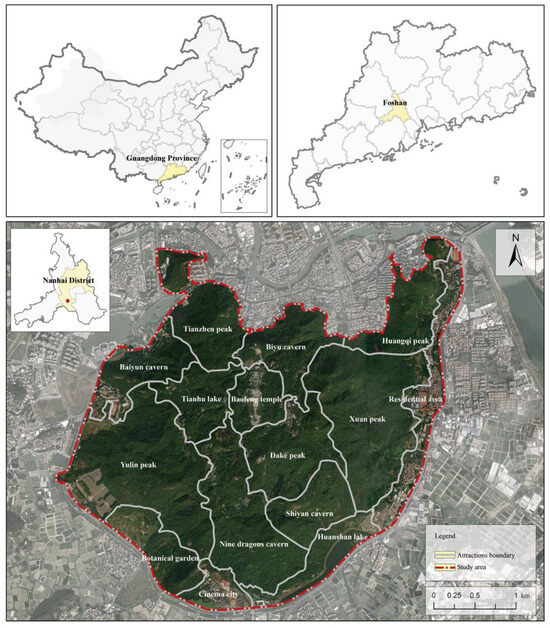
Figure 1.
Location and distribution of the study area.
2.2. Data Sources
QuickBird imagery (resolution: 0.6 m) from the QuickBird satellite (DigitalGlobe Co., Westminster, CO, USA) was used as the foundational data source. The imagery was obtained from Google Earth and was captured on 13 October 2021. The imagery was projected in the WGS 1984 Web Mercator, a commonly used web-based mapping program. Based on GPS control points acquired from field surveys, highly accurate geometric corrections were applied to the QuickBird imagery using the ArcGIS 10.6 software to ensure that any errors were less than 0.5 pixels. The visible band was used to analyze the imagery, and image classification was based on visual interpretations. To ensure the accuracy of the classification map, the screen resolution was maintained within a scale of 1:1000. Field surveys and land class validation were conducted in April and May 2022, respectively. A total of 1055 GPS verification points were collected, with approximately 100 verification points for each land class. The overall classification accuracy and kappa coefficient for image interpretation were 95.25% and 0.95, respectively, meeting the research requirements.
2.3. Landscape Classification
Following the standards outlined in the “Technical regulation of the third nationwide land survey” (TD/T 1055-2019) for land classification, and considering the functional characteristics of various landscapes within the study area, they were classified into five primary landscape types: farmland, grassland, water bodies, forest, and construction land. Considering the limited farmlands, grasslands, and water bodies, and the predominance of forests and construction land, the landscapes were subdivided further (Table A1), resulting in the identification of 12 secondary landscape types (Figure 2).
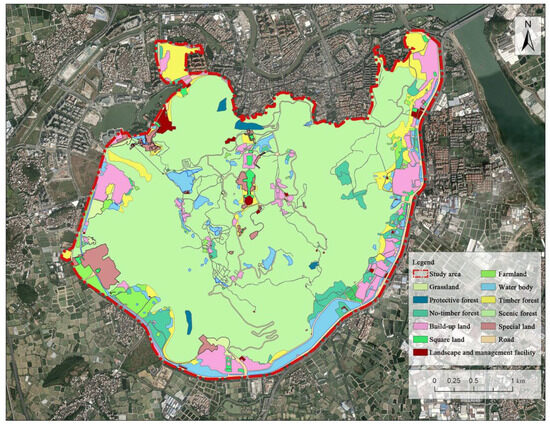
Figure 2.
Map showing landscape classification of secondary landscape types in the study area.
2.4. Landscape Function Classification
Landscape classification forms the foundation of a landscape structure analysis, and the spatial variation of landscape structure is a specific manifestation of functional heterogeneity [33,34]. Currently, suburban forest parks are primarily classified based on land use type; however, they do not adequately reflect their multifunctionality. Therefore, this study expanded its classification system for park patches and corridor landscapes from a multifunctional perspective and introduced the dual-purpose functionality that integrates both eco-conservation and recreation in addition to the existing eco-conservation and recreation functionalities. Consequently, a three-tiered landscape functional classification system (Table 1) was developed. The spatial distribution maps of the landscape function types within the study area are presented in Figure A1 and Figure A2.

Table 1.
Classification levels of landscape functions.
2.5. Index System and Methods to Evaluate Landscape Health
Building upon prior research findings regarding landscape health assessment indicators [10], this study incorporated the landscape characteristics of Xiqiao Mountain National Forest Park and constructed various indicators and parameters that reflect the ecological conservation, recreation, and dual-purpose functionalities. The landscape health indicators for the three functionalities all included 7 patch-based indicators and 7 corridor-based indicators. Some of the dual-purpose functionality indicators (Z4 and Z8) were obtained by integrating the indicators of ecological conservation and recreational functions (Table 2).

Table 2.
Indices of landscape health evaluation.
Based on the median area of all the patches and corridors in the study area (1273 m2), square grids with sides measuring 36 m were selected as a basic sampling unit. Furthermore, square grids with sides measuring 18 m (0.5 times the base side length) and 54 m (1.5 times the base side length) were also selected as basic sampling units. The study area was gridded using the three types of basic sampling units, consecutively. Grid cells with areas less than half of the sampling unit were excluded, resulting in totals of 40,280, 10,071, and 4484 sampling units for the 18, 36, and 54 m sizes, respectively. Following the calculation methods for the various indices (Table 3), and utilizing the ArcGIS spatial analysis module, the index values for the patches and corridors were computed based on ecological conservation, recreational, and dual functions within each sampling unit. To calculate Z4 and Z8 indicators, ecological preservation and recreational utilization formulas were applied separately. After standardization, each value was halved, and any inverse indicators were transformed into positives. These transformed values were then added to the positive indicators to derive dual-purpose functionality indicators.

Table 3.
Index calculations in the landscape health evaluation.
2.6. Methods to Comprehensively Evaluate Landscape Health
2.6.1. Determination of Index Weights
The entropy method offers the advantages of a simple calculation process, high accuracy, and strong objectivity [35,36]. This method is based on the degree of variation in each index and uses information entropy to calculate the entropy weight of each index, and it subsequently adjusts the weights of each index to obtain objective index weights [37]. To reduce the subjectivity in the evaluation process and to avoid the interference of human factors on the weights, this study chose the entropy method to determine the index weights. The results of the calculation of the weights for each index are presented in Table A2.
2.6.2. Landscape Health Assessment
The assessment values for eco-conservation, recreational, and dual-purpose landscapes in each sampling unit were calculated by multiplying the standardized values of each evaluation index (Table 2) by their corresponding weight coefficients (Table A2) and then summing the values. The comprehensive landscape health was obtained by summing the assessment values of eco-conservational, recreational, and dual-purpose landscapes:
where Zi represents the comprehensive landscape health of the sampling unit i; Ei represents the eco-conservational functionality assessment value of the sampling unit i; Ri represents the recreational function assessment value of the sampling unit i; Ci represents the dual-purpose functionality assessment value of the sampling unit i.
Zi = Ei + Ri + Ci
As the dual-purpose functionality incorporates both eco-conservational and recreational functions, the landscape health of eco-conservational functionality for each sampling unit was determined by summing the eco-conservational functionality assessment value and half of the dual-purpose functionality assessment value (i.e., Ei + 0.5Ci). Similarly, the landscape health of recreational functionality was determined by summing the recreational functionality assessment value and half of the dual-purpose functionality assessment value (i.e., Ri + 0.5Ci). Based on the calculation results, eco-conservational, recreational, and comprehensive landscape health for each sampling unit were normalized and categorized into five levels: very poor (0–0.2), poor (0.2–0.4), fair (0.4–0.6), good (0.6–0.8), and very good (0.8–1). Finally, utilizing ArcGIS and the Kriging spatial interpolation method, the spatial visualization of the landscape health assessment results was performed for each sampling unit, resulting in spatial distribution maps of landscape health across multiple sampling units and functionalities.
2.7. Method Framework
This study performed geometric corrections and visual interpretations of QuickBird satellite imagery of Xiqiao Mountain National Forest Park. Based on landscape and landscape function classifications, indicators and parameters that reflect ecological conservation, recreation, and dual-purpose functionalities were constructed. The entropy method was then applied to determine the index weights, as well as the eco-conservation, recreational, and dual-purpose landscape assessment values, which were ultimately used to generate eco-conservation, recreational and comprehensive landscape health. This study also analyzed landscape health from three perspectives: spatial distributions of landscape health, landscape health disparities, and the relationship between landscape health and internal landscape factors in forests (Figure 3).
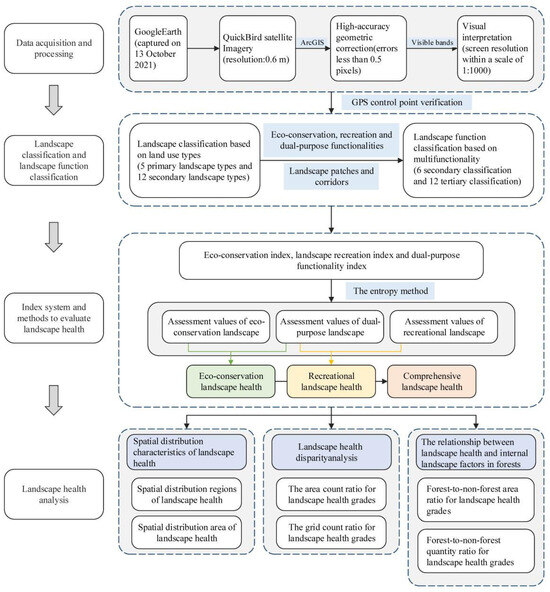
Figure 3.
Method framework used in this study.
3. Results
3.1. Spatial Distribution Characteristics of Landscape Health
As shown in Figure 4a, Figure 5a, Figure 6a, within different sampling units, regions with “very good” and “good” eco-conservation landscape health grades are primarily concentrated in the northern (Tianzhen Peak, Biyu Cavern), central–southern (Dake Peak, Shiyan Cavern), and southwestern (Yulin Peak, Botanical Garden) regions of the park, occupying 1.14%, 1.55%, and 1.77% of the total area, respectively. Conversely, areas with “very poor” and “poor” grades account for 98.86%, 98.43%, and 98.14% of the total area, respectively.
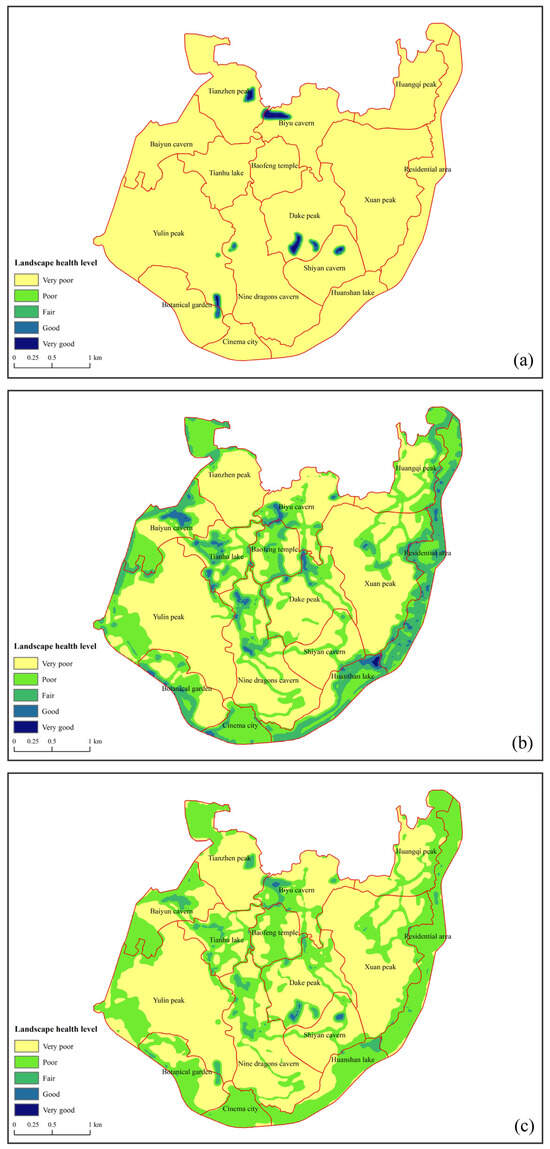
Figure 4.
Landscape health maps showing the spatial distributions of eco-conservation (a), recreational (b), and comprehensive (c) functions for 18 m × 18 m sampling units.
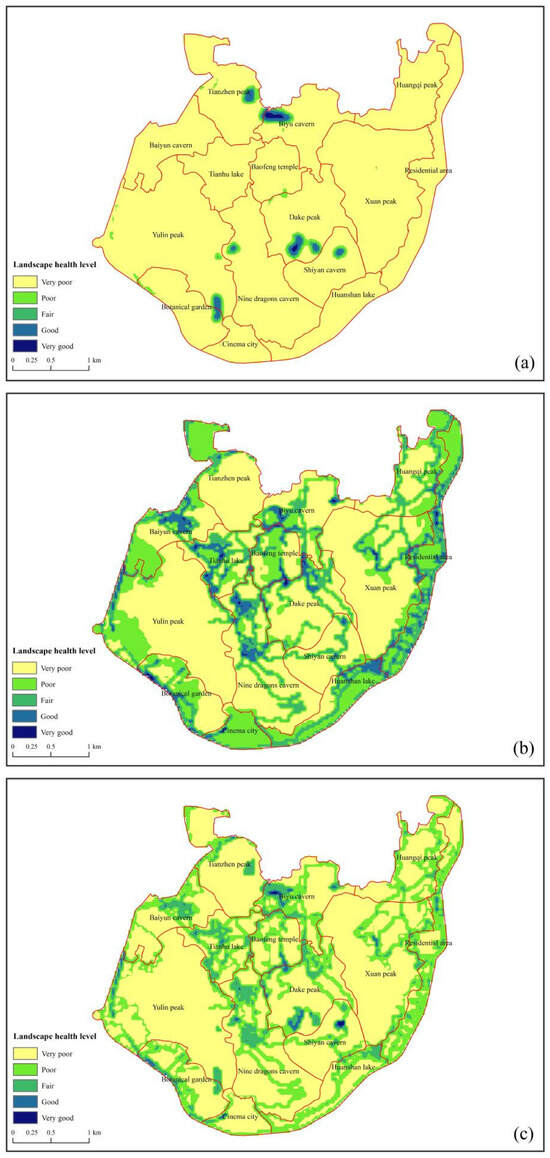
Figure 5.
Landscape health maps showing the spatial distributions of eco-conservation (a), recreational (b), and comprehensive (c) functions for 36 m × 36 m sampling units.
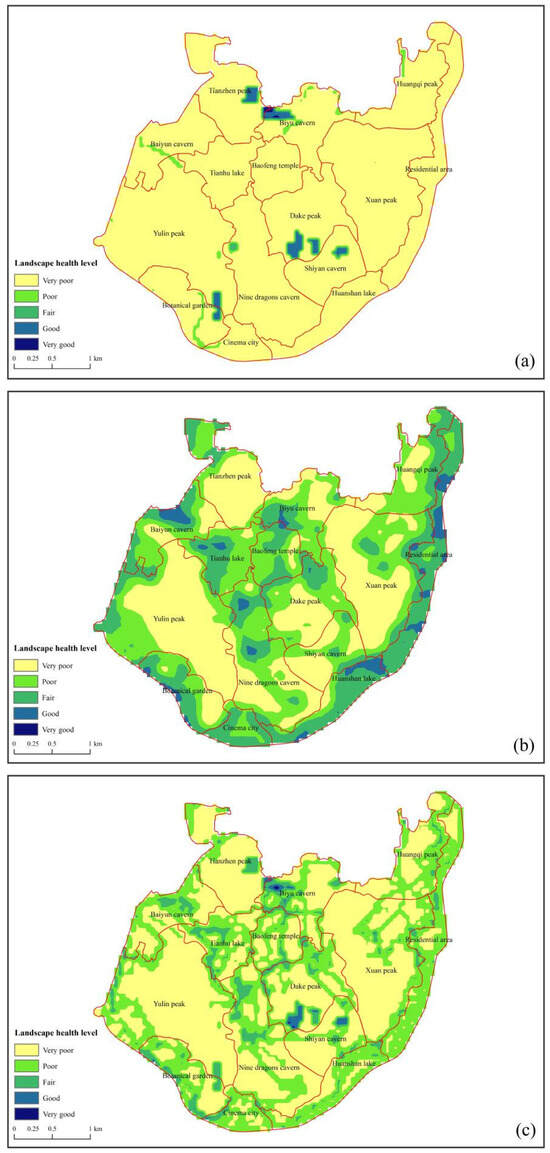
Figure 6.
Landscape health maps showing the spatial distributions of eco-conservation (a), recreational (b), and comprehensive (c) functions for 54 m × 54 m sampling units.
Figure 4b, Figure 5b, Figure 6b show that among the different sampling units, areas with “very good” and “good” landscape health grades for recreational functionality are primarily distributed in the central (Tianhu Lake, Baofeng Temple), central–southern (Nine Dragons Cavern, Dake Peak), and peripheral regions around the park (Baiyun Cavern, Botanical Garden, Cinema City, Huanshan Lake, residential area), occupying 6.16%, 8.08%, and 17.20% of the total area, respectively. Conversely, areas with “very poor” and “poor” grades account for 86.39%, 76.99%, and 69.46% of the total area, respectively.
According to Figure 4c, Figure 5c, Figure 6c, within the 18 m × 18 m and 54 m × 54 m sampling units, the regions with “very good” and “good” comprehensive landscape health grades are concentrated in the northern (Biyu Cavern) and central–southern regions (Dake Peak, Shiyan Cavern) of the park, accounting for 1.08% and 1.07% of the total area, respectively. In the 36 m × 36 m sampling units, areas with “very good” and “good” landscape health grades are distributed in the aforementioned regions, as well as in the central (Tianhu Lake, Nine Dragons Cavern, Baofeng Temple), eastern (Xuan Peak), and the peripheral (Yulin Peak, Botanical Garden, Cinema City, residential areas) regions around the park, accounting for 1.49% of the total area. Regions with “very poor” and “poor” health grades account for 88.62%, 88.65%, and 88.83% of the total area, respectively.
3.2. Landscape Health Disparity Analysis
Figure 7a, Figure 8a, Figure 9a show that the total area and grid count ratios for the “very good” and “good” grades of eco-conservation landscape health display a slight increasing trend. In contrast, the total area and grid count ratios for “very poor” and “poor” grades exhibit a slight decreasing trend.
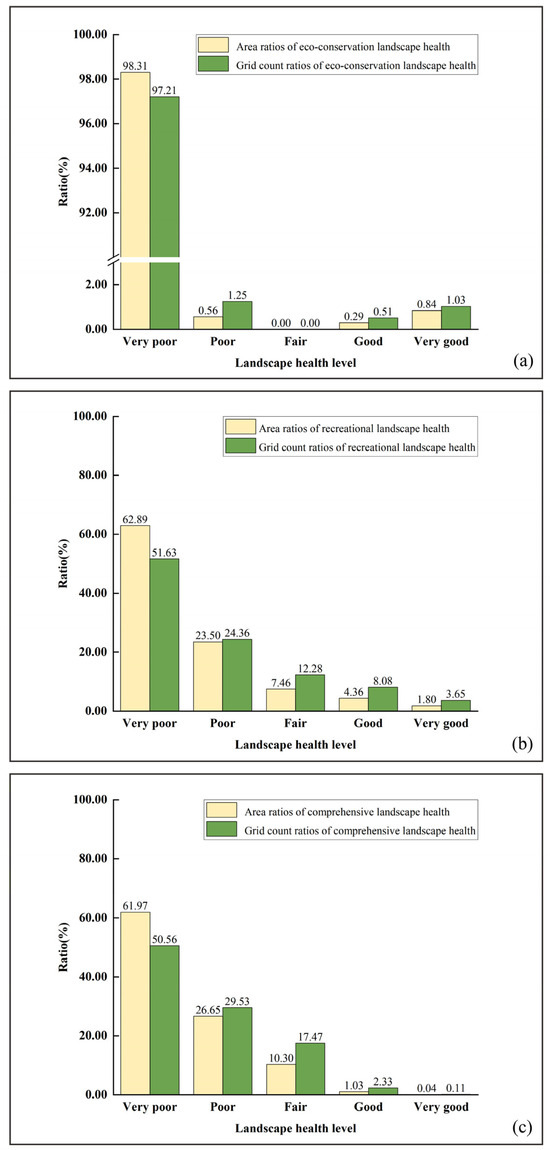
Figure 7.
Landscape health disparity analysis of eco-conservation (a), recreational (b), and comprehensive (c) functions for 18 m × 18 m sampling units.
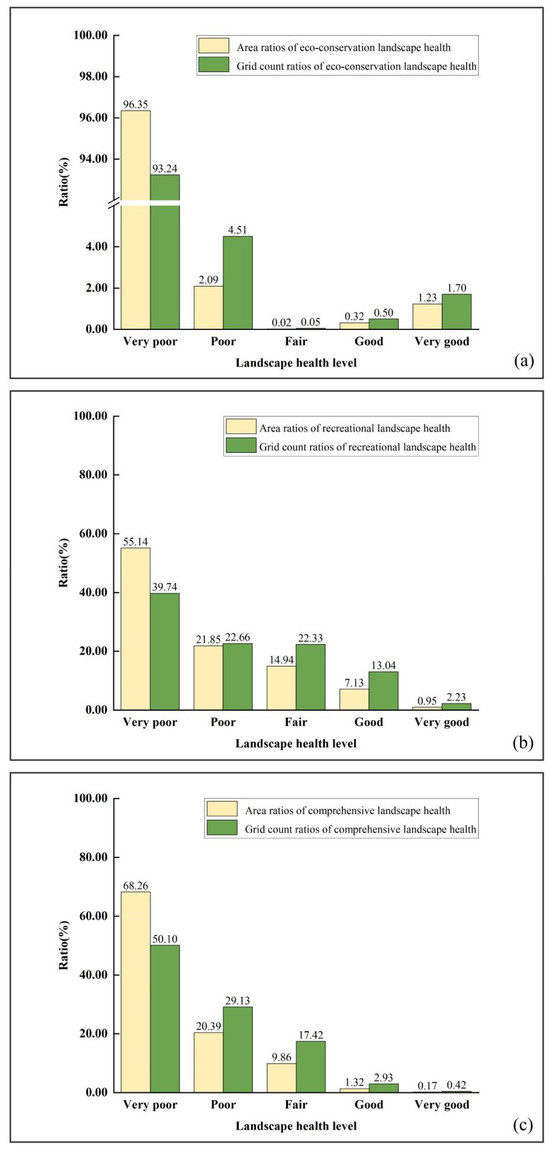
Figure 8.
Landscape health disparity analysis of eco-conservation (a), recreational (b), and comprehensive (c) functions for 36 m × 36 m sampling units.
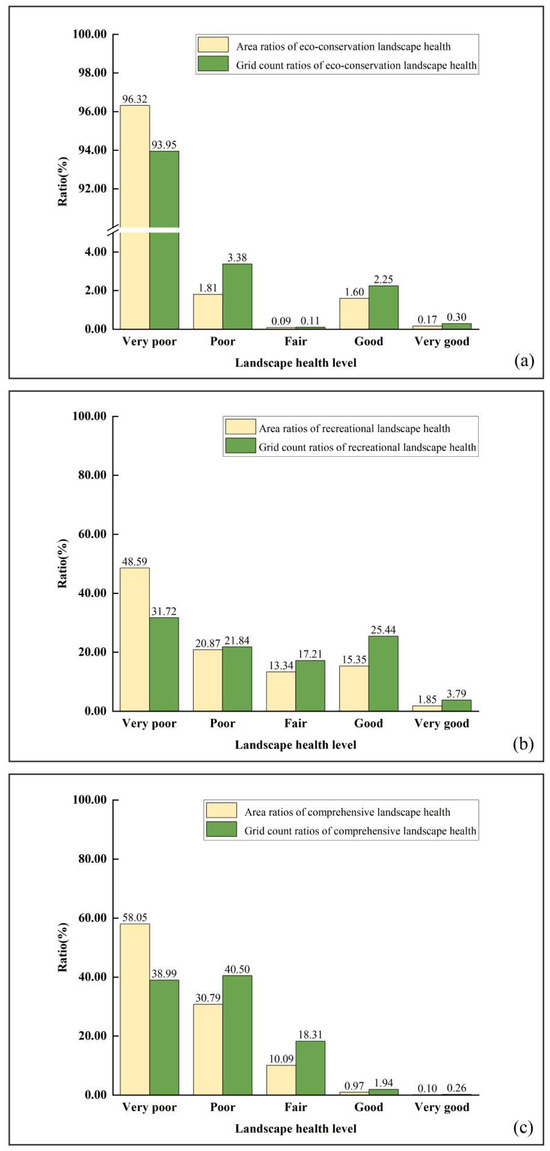
Figure 9.
Landscape health disparity analysis of eco-conservation (a), recreational (b), and comprehensive (c) functions for 54 m × 54 m sampling units.
In terms of recreational landscape health, Figure 7b and Figure 8b show that the total area and grid count ratios for the “very good” and “good” grades display a slight increasing trend. The reduction in the total grid count ratio for the “very poor” and “poor” grades is slightly lower (0.82) than that of their total area ratio (0.89). Figure 8b and Figure 9b indicate that the increase in the total grid count ratio for the “very good” and “good” landscape health grades for recreational functionality is lower (1.91) than that of their total area ratio (2.13). The decrease in the total grid count ratio for the “very poor” and “poor” grades is slightly lower (0.86) than that of their total area ratio (0.90).
Figure 7c, Figure 8c, Figure 9c indicate that in terms of comprehensive landscape health, the total area ratio and the total grid count ratio for the “very good” and “good” grades display a trend of initially increasing and subsequently decreasing; however, the change is not significant. The total area ratio for the “very poor” and “poor” grades display a slight increase, whereas the total grid count ratio exhibits a trend of initially decreasing and subsequently increasing; however, the change is not significant in both.
From this, it can be inferred that the influence of different sampling unit sizes on eco-conservational, recreational, and comprehensive landscape health is not significant. Therefore, using the largest basic sampling unit of 54 m × 54 m to partition the park is sufficient to analyze its landscape health status.
3.3. The Relationship between Landscape Health and Internal Landscape Factors in Forests
As the landscape health grade of eco-conservation functionality improved, the forest-to-non-forest area ratio in the 18 m × 18 m and 36 m × 36 m basic sampling units displayed a fluctuating decreasing trend characterized for the former by an initial decline followed by an increase and then another decline and for the latter by a fluctuating upward trend, respectively. In contrast, in the 54 m × 54 m basic sampling unit, the forest-to-non-forest area ratio exhibited an “N”-shaped fluctuating increasing trend. The forest-to-non-forest patch ratio in the 18, 36, and 54 m basic sampling units exhibited “V”-shaped, “W”-shaped, and “N”-shaped fluctuating increasing trends, respectively. As the basic sampling unit size increased—with area ratios of 2.76, 3.55, and 24.23 and quantity ratios of 2.99, 2.69, and 3.00—the highest health grade for eco-conservation functionality was achieved (Table 4).

Table 4.
Ratios of forest-to-non-forest landscape area and quantity for each health grade.
As the health grade for recreational functionality improved, the forest-to-non-forest area ratio and quantity ratio in different basic sampling units both exhibited a “W”-shaped fluctuating decreasing trends. As the basic sampling unit size increased—with area ratios of 0.58, 0.99, and 0.83 and quantity ratios of 0.50, 0.78, and 0.68, respectively—the health grade for recreational landscapes reached its highest level (Table 4).
As the health grade for comprehensive landscapes improved, in the 18 m × 18 m basic sampling units, the forest-to-non-forest area ratio displayed a “V”-shaped fluctuating decreasing trend, whereas the forest-to-non-forest quantity ratio exhibited a fluctuating decreasing trend with an initial drop followed by a rise and then another drop. In the 36 m × 36 m basic sampling units, both forest-to-non-forest area ratio and quantity ratio displayed “W”-shaped fluctuating decreasing trends. As the health grade for comprehensive landscapes improved, in the 54 m × 54 m basic sampling units, both the forest-to-non-forest area ratio and quantity ratio showed “V”-shaped fluctuating decreasing trends. As the basic sampling unit size increased—with area ratios of 7.83, 2.23, and 4.41 and quantity ratios of 2.70, 1.24, and 0.91, respectively—the highest health grade for the comprehensive landscapes was achieved (Table 4).
4. Discussion
4.1. Spatial Distribution of Landscape Health in Xiqiao Mountain National Forest Park under Multiple Sampling Units and Functions
Under multiple sampling units and functionalities, the spatial distributions of the “very poor” and “poor” landscape health grades in Xiqiao Mountain National Forest Park were most extensive, covering the largest area and forming a sheet-like pattern across the entire park. In contrast, the spatial distributions of the “very good” and “good” landscape health grades were scattered, covering the least area. They were primarily found in block-like and linear patterns in the northern, central, and central–southern regions of the park. For example, in terms of eco-conservational landscapes under different sampling units, areas with “very good” and “good” health grades were distributed in block-like patterns in the northern, central-southern, and southwestern regions of the park, covering less than 2.00% of the total area. Similarly, areas with “very good” and “good” health grades for recreational landscapes were distributed in block-like and linear patterns within the central, south-central, and peripheral regions of the park, covering more than 6.00% of the total area. In the case of comprehensive landscapes, areas with “very good” and “good” health grades were primarily concentrated in block-like patterns in the northern and central-southern parts of the park, covering less than 1.50% of the total area. From the above findings, it can be inferred that areas with high health grades for eco-conservational landscapes have a more significant impact on the spatial distribution of comprehensive landscapes within the park compared to areas for recreational landscapes. Previous research has indicated that the construction of geological and wetland parks requires a focus on ecological conservation [38,39]. Similarly, the present study emphasizes the importance of prioritizing ecological conservation when developing suburban forest parks. However, for eco-conservational landscapes in the different sampling units, areas with “very bad” and “bad” health grades accounted for more than 98.00% of the total area. This occurred because the landscape health of eco-conservational functionality for each sampling unit was determined by adding the eco-conservational functionality assessment value and half of the dual-purpose functionality assessment value, while the area covered by eco-conservation landscape patches and corridors in the park was relatively small (Figure A1 and Figure A2), and scenic forests in dual-purpose landscape patches were widely distributed and covered a large area (67.84% of the total park area). This finding indicates that the planning and layout of suburban forest parks in a large area of single forests is not conducive to the overall eco-conservational function of the park. Therefore, in addition to focusing on managing the integrity of the forest landscape and ensuring intensive utilization of forest land, it is also necessary to enhance the diversity of the forest landscape.
Under the framework of multi-sampling units, significant differences were observed in the landscape health spatial distribution between eco-conservational and recreational landscapes within Xiqiao Mountain National Forest Park. From the data, it was evident that as the basic sampling unit size increased, the areas with “very good” and “good” health grades for recreational landscapes accounted for 6.16%, 8.08%, and 17.20% of the total area, whereas the areas with “very good” and “good” landscape health grades for eco-conservation functionality accounted for 1.13%, 1.55%, and 1.77%, respectively. This indicates that the recreational functionality of Xiqiao Mountain National Forest Park is prioritized over eco-conservation. This may be attributed to the fact that suburban forest parks, serving as the primary destination for outdoor recreation among urban residents, need to meet people’s strong recreational demands. Consequently, Xiqiao Mountain National Forest Park has intensified infrastructure development and improved park transportation, leading to higher values for indicators such as area, density, diversity, and connectivity of recreational patches and corridors. This also indicates that people’s recreational demands are a crucial factor influencing the health of suburban forest parks.
Based on the above findings, although eco-conservational functionality has a stronger dominance in shaping the overall health of the park, the current development focus of the park leans more toward enhancing recreational functions. Moreover, the overlapping areas of “very good” and “good” landscape health grades for recreational functionality, and “very poor” and “poor” for ecological conservation functionality under different sampling units, account for 6.15%, 8.03%, and 17.13%, respectively. This percentage is greater than that of the overlapping areas of “very good” and “good” landscape health grades for ecological conservation functionality and “very poor” and “poor” landscape health grades for recreational functionality, which are 1.09%, 1.35%, and 1.59%, respectively. However, the overlapping areas with landscape health grades for both functions rated as “very good” and “good” are all below 0.10%. Similar to previous research findings [10], ecological conservation and recreational landscape health are both interdependent and coexist in terms of their spatial distribution. This emphasizes the importance of achieving a balance and synergy between various functions in the actual construction and development of suburban forest parks [40] to effectively enhance landscape health.
4.2. Effect of Varying Sampling Unit Sizes on the Landscape Health of Xiqiao Mountain National Forest Park under Multi-Functions
The results of our study suggest that the three different sizes of fundamental sampling units did not exhibit significant differences in their impact on the landscape health of multi-functional suburban forest parks. Therefore, utilizing the largest fundamental sampling unit of 54 m × 54 m to partition the park area is adequate for accurately assessing the park’s landscape health. In prior landscape health studies conducted in parks with areas ranging from 10 to 15 km2 [10,32], the dimensions of their sampling units were determined based on the average area of park patches and corridors. However, the resulting sampling unit sizes were all larger than 300 m × 300 m, with a grid count of fewer than 150 sampling units. Landscape health assessment is, to a certain extent, dependent on the spatial scale. The larger the spatial sampling unit, the less accurate the assessment results may be, increasing the likelihood of inaccuracies in landscape health assessment results [41]. Therefore, in this study, the median area of patches and corridors was used as the basic research scale (36 m × 36 m), and expanded studies were conducted at 0.5 times and 1.5 times the scale (18 m × 18 m and 54 m × 54 m, respectively), resulting in 10,071, 40,280, and 4484 sampling units, respectively. Furthermore, the results of this study further confirm that smaller sampling unit sizes and a larger number of sampling units do not necessarily favor landscape health analysis, as smaller spatial sampling unit scales can lead to a large number of outliers and poorer spatial continuity [42]. In addition, owing to differences in regional location, topographic slope, vegetation, and other aspects, the optimal grid size also differs. For example, in the urban community park in East Delhi, India, the health assessment of its greenness was based on a 20 m × 20 m sampling unit [43]. To measure bird activity in the suburban areas of Shenzhen, China, Yangtaishan Forest Park was divided into equally distanced 80 m × 80 m grids [44]. In rural areas of Poland, a 500 m × 500 m grid was appropriate for analyzing the conservation value of flora in Gopło Millennium Park [45]. Thus, setting a reasonable grid size is the basis for analyzing park landscapes. In this study, the sampling unit size was determined based on the median area of patches and corridors, which also expands the method for selecting the optimal grid size for landscape-scale analyses of suburban forest park landscape health.
4.3. The Relationship between Landscape Health and Interior Landscape Factors within the Forest in Xiqiao Mountain National Forest Park with Multiple Sampling Units and Functions
As the landscape health grade for eco-conservation functionality improved, the forest/non-forest area ratio and quantity ratio generally exhibited a fluctuating upward trend. In contrast, as the landscape health grade for recreational functionality improved, the forest/non-forest area ratio and quantity ratio generally displayed a fluctuating downward trend. This is due to a stronger correlation between forest area and biodiversity conservation, whereas the association with recreational activities is weaker. In areas where biodiversity conservation is better, people may not have a strong inclination for recreational activities, and they tend to prefer engaging in leisure activities in areas with well-developed infrastructure and convenient transportation. In addition, previous studies have discussed the relationships between the sizes of urban forest patches and the functions of ecosystem and recreational services at the urban scale [46,47]. This study further refined the forest landscapes at a landscape scale and analyzed the health conditions within the interiors of forest landscapes using the forest-to-non-forest area ratio and quantity ratio. This study also confirms that adjusting the forest/non-forest area ratio and quantity ratio can be an effective measure to improve the landscape health level of suburban forest parks. It is important to note that implementing this measure should ensure the use of native tree species. Previous studies have shown that, although native tree species grow slowly into forests, they have strong water and soil conservation abilities and high species richness [48,49], which can effectively protect species diversity and improve ecosystem health levels. However, notably, there is no overlap in the forest/non-forest area ratio and quantity ratio values for “very good” and “good” landscape health grades of both eco-conservation and recreational functions across different sampling units. This suggests that there is not strong synergy between eco-conservation and recreational functions in Xiqiao Mountain National Forest Park. This lack of synergy could be a reason contributing to the relatively poor landscape health in the park. Therefore, it is necessary to enhance the synergistic promotion of multiple functions in suburban forest parks, and further research is required on the relationship between landscape health based on function synergism and threshold intervals of forest/non-forest area ratio and quantity ratio.
4.4. Limitations and Future Research
This study employed different sampling unit sizes and a multifunctional perspective to partition the landscape into patches and corridors. This enhances the comprehensiveness and accuracy of landscape health assessment in suburban forest parks. However, this study also has certain limitations. First, it is important to note that the weights assigned to the different indicators could directly influence the results of landscape health assessment [50]. Although the present study used the entropy weight method, which has good objectivity, this approach does not reduce the dimensionality of evaluation indicators. In future research, a combination of analytic hierarchy process (AHP) and entropy weight method could be employed to calculate composite weights. Second, the landscape health assessment is an objective diagnosis of changes in landscape conditions over time. The relative state of health or unhealthiness can only be determined through the application of comparative perspectives [51]. The landscape health assessment conducted in the present study provided a static snapshot; however, landscape health is inherently a dynamic process. In future studies, it is essential to undertake long-term, dynamic monitoring and research to delve into the driving factors and mechanisms affecting landscape health. Through appropriate interventions and management, the goal should be to sustainably maintain the landscape health of suburban forest parks in a favorable state. The results of this study are specific to Xiqiao Mountain National Forest Park, and their applicability to other suburban forest parks requires further research. In future studies, expanding the scope of research to include a variety of suburban forest parks in Guangdong Province could be undertaken, each with its unique characteristics, would facilitate a comparative study. This approach could yield more generalized research conclusions and enhance the overall research value.
5. Conclusions
This study used Xiqiao Mountain National Forest Park as a case study. It employed satellite remote sensing imagery to extract landscape types and constructed a landscape functional classification system reflecting multifunctional characteristics; 42 landscape health assessment indicators were selected, and their weights were determined using the entropy weight method. Landscape health values were calculated for varying sampling units and functional characteristics using the grid analysis method. The study also utilized Kriging spatial interpolation to analyze the spatial distribution of landscape health within the study area. Furthermore, it explored the variations in the impact of different sampling units on landscape health as well as the relationship between landscape health and landscape factors. The main conclusions were as follows: (1) Under multiple sampling units and functional characteristics, the spatial distribution of the “very poor” and “poor” landscape health grades in Xiqiao Mountain National Forest Park were most extensive (occupying 69.46% to 98.86% of the total area), forming a sheet-like pattern throughout the park. In contrast, the spatial distribution of the “very good” and “good” landscape health grades were scattered (occupying 1.07% to 17.20% of the total area), primarily forming block and linear patterns in the northern, central, and southern regions of the park. (2) Under different sampling units, significant differences were detected in the landscape health spatial distribution between the eco-conservation and recreational functions in Xiqiao Mountain National Forest Park. The areas with “very good” and “good” landscape health grades for eco-conservation functions differed from those for recreational functions by 5.03% to 15.43%. (3) The influence of three different sampling unit sizes on the landscape health of Xiqiao Mountain National Forest Park under multifunctional characteristics were not significantly different. The 54 m × 54 m basic sampling unit was the optimal grid size for analyzing landscape health in the park in this study. (4) With the increase in landscape health grades for eco-conservation functions, the forest/non-forest area ratio as well as the quantity ratio generally displayed a fluctuating upward trend. However, with the increase in health grades for recreational landscapes, the forest/non-forest area ratio and quantity ratio generally displayed a fluctuating downward trend. The forest/non-forest area ratio and quantity ratio were important factors influencing the landscape health of suburban forest parks. The results of this study provide technical support for the planning, construction, and management decisions of suburban forest parks. This study also offers practical case references for implementing differentiated eco-conservation, recreational measures, and recommendations.
Despite the efforts to minimize the disruption of the natural environment during the planning and construction of Xiqiao Mountain National Forest Park, while meeting the recreational needs of visitors, it has emerged as a primary destination for tourism, vacations, and leisure recreation for residents in the surrounding cities. However, the research results indicate that the park remarkably prioritizes recreational functionality. Therefore, there is a need to intensify efforts to enhance the health of eco-conservation landscapes in the park. Moreover, a complex relationship in the park exists in which eco-conservation and recreational functions both coexist and mutually restrict each other. Isolating or opposing these two functions could lead to either excessive development or a mechanistic and passive approach to conservation. Therefore, while prioritizing eco-conservation in Xiqiao Mountain National Forest Park, it is essential to carefully identify the areas in which eco-conservation and recreational functions exist independently and overlap. Subsequently, differentiated protection and utilization measures should be implemented accordingly. For example, ecological conservation standalone areas should be designed in the form of large patches and extensive corridors, whereas recreational standalone areas should primarily cater to the recreational needs of visitors. Overlay zones, in which ecological preservation takes precedence over supplementary recreational activities, can leverage ecological resources to introduce moderate recreational activities. Conversely, in overlay zones primarily focused on recreational functionality, with ecological preservation as a secondary goal, ecological resources should be used to enhance the environmental quality of recreational infrastructure land. Furthermore, there is a synergy between ecological conservation and recreational functions, and it is essential to focus on their collaborative development to maximize the utility of limited spatial resources. Therefore, in the conservation and development of suburban forest parks, a collaborative planning and design approach should be adopted to enhance both ecological conservation and recreational potential, simultaneously. For example, when developing areas within suburban forest parks for recreational purposes, increasing the forest-to-non-forest area and quantity ratios, maintaining a low level of fragmentation, and promoting ecological connectivity would contribute to enhancing their ecological preservation function. Although it may be challenging to fully restore the ecological preservation function of extensively used land within suburban forest parks, viable approaches could include enhancing ecological diversity and establishing ecological corridors [40,52].
Author Contributions
Conceptualization, H.L. and Q.Z.; methodology, H.L. and Q.Z.; investigation, H.L., Q.Z. and L.Z.; formal analysis, H.L.; visualization, H.L.; writing—original draft preparation, H.L.; writing—review and editing, H.L., Q.Z., L.Z., C.G., X.W. and Y.N.; supervision, Q.Z.; funding acquisition, Q.Z. All authors have read and agreed to the published version of the manuscript.
Funding
This research was funded by the Forestry Science and Technology Innovation Project of Guangdong Province [grant No. 2022KJCX009 and No. 2021KJCX009].
Data Availability Statement
We do not provide public access to the dataset due to protection of the privacy of the participants. Regarding the details of the data, please contact the corresponding author.
Conflicts of Interest
The authors declare no conflict of interest.
Appendix A

Table A1.
Landscape classification system of the study area.
Table A1.
Landscape classification system of the study area.
| Number | Primary Classification | Secondary Classification | Description |
|---|---|---|---|
| 1 | Farmland | Farmland | Farmland dedicated to the cultivation of water-dependent crops, such as rice and lotus. In addition, this includes areas in which the practice of crop rotation between water-based and dryland crops, and cultivated land that relies on artificial irrigation for the cultivation of dryland crops, including vegetables. |
| 2 | Grassland | Grassland | Artificially planted grassland with a tree canopy density of <0.1, intended for scenic viewing or recreational relaxation, and barren grassland with a tree canopy density of <0.1, characterized by a soil surface and the growth of various weeds. |
| 3 | Water body | Water body | Natural or artificially excavated rivers, lakes, ponds, as well as artificially constructed ditches used for water diversion, drainage, and irrigation. |
| 4 | Protective forest | Protective forest | A forest primarily designed to preserve soil, prevent wind and sand erosion, conserve water sources, regulate climate, reduce pollution, and improve the ecological environment and human production and living conditions. |
| Timber forest | A forest primarily intended for the production of timber and wood fiber. | ||
| No-timber forest | A forest primarily intended for the production of non-timber forest products such as fruits, edible oilseeds, beverages, spices, industrial raw materials, and medicinal plants. | ||
| Scenic forest | A forest primarily intended for aesthetic purposes, providing opportunities for people to relax, play, and enjoy natural scenery. | ||
| 5 | Construction land | Square land | A public space primarily intended for recreational activities, fitness, commemoration, gatherings, and refuge. |
| Built-up land | Refers to residential homes as well as buildings such as restaurants and hotels. | ||
| Landscape and management facility | Refers to leisure landscape facilities such as pavilions, walkways, and pergolas in forest parks, as well as management and service facilities such as restrooms, dining establishments, convenience stores, and visitor centers. | ||
| Special land | Refers to land designated specifically for military purposes, religious activities, or burial sites. | ||
| Road | Mainly refers to roadways for vehicles and pedestrian walkways. |

Table A2.
Calculation results of evaluation index weights.
Table A2.
Calculation results of evaluation index weights.
| Functional Attributes | Evaluation Indicators | 18 m × 18 m Basic Sampling Unit | 36 m × 36 m Basic Sampling Unit | 54 m × 54 m Basic Sampling Unit | |||
|---|---|---|---|---|---|---|---|
| Entropy Value | Weight | Entropy Value | Weight | Entropy Value | Weight | ||
| Eco-conservation function | X1 | 0.87 | 16.36% | 0.86 | 14.14% | 0.83 | 13.99% |
| X2 | 0.84 | 20.55% | 0.80 | 20.57% | 0.77 | 18.48% | |
| X3 | 1.00 | 0.12% | 0.98 | 2.40% | 0.97 | 2.31% | |
| X4 | 0.84 | 20.53% | 0.79 | 20.71% | 0.76 | 18.99% | |
| X5 | 0.84 | 20.55% | 0.80 | 20.57% | 0.77 | 18.52% | |
| X6 | 0.99 | 0.85% | 0.99 | 1.18% | 0.94 | 4.64% | |
| X7 | 0.99 | 1.56% | 0.98 | 2.39% | 1.00 | 0.00% | |
| X8 | 1.00 | 0.38% | 0.86 | 14.44% | 0.97 | 2.52% | |
| X9 | 0.88 | 15.59% | 1.00 | 0.00% | 0.76 | 18.93% | |
| X10 | 1.00 | 0.32% | 1.00 | 0.25% | 0.98 | 1.61% | |
| X11 | 1.00 | 0.00% | 1.00 | 0.00% | 1.00 | 0.00% | |
| X12 | 1.00 | 0.00% | 1.00 | 0.00% | 1.00 | 0.00% | |
| X13 | 1.00 | 0.00% | 1.00 | 0.00% | 1.00 | 0.00% | |
| X14 | 0.97 | 3.20% | 0.97 | 3.34% | 1.00 | 0.00% | |
| Recreational function | Y1 | 0.89 | 11.38% | 0.88 | 8.01% | 0.87 | 10.83% |
| Y2 | 0.90 | 10.50% | 0.90 | 6.96% | 0.90 | 8.30% | |
| Y3 | 1.00 | 0.36% | 0.99 | 0.81% | 0.95 | 4.29% | |
| Y4 | 1.00 | 0.24% | 1.00 | 0.24% | 0.99 | 0.73% | |
| Y5 | 0.90 | 10.50% | 0.90 | 7.01% | 0.90 | 8.30% | |
| Y6 | 0.87 | 13.62% | 0.85 | 10.16% | 0.83 | 13.85% | |
| Y7 | 0.91 | 9.54% | 0.90 | 6.53% | 0.97 | 2.15% | |
| Y8 | 0.88 | 12.71% | 0.86 | 9.18% | 0.88 | 10.02% | |
| Y9 | 0.84 | 16.38% | 0.86 | 9.39% | 0.88 | 10.05% | |
| Y10 | 0.99 | 1.04% | 0.86 | 9.39% | 0.93 | 6.09% | |
| Y11 | 1.00 | 0.00% | 0.97 | 1.84% | 1.00 | 0.00% | |
| Y12 | 0.98 | 2.27% | 0.87 | 8.49% | 0.88 | 9.65% | |
| Y13 | 0.91 | 8.86% | 0.81 | 12.89% | 0.85 | 12.14% | |
| Y14 | 0.97 | 2.61% | 0.87 | 9.12% | 0.96 | 3.61% | |
| Dual-purpose functionality | Z1 | 0.97 | 6.70% | 1.00 | 0.00% | 0.94 | 6.87% |
| Z2 | 0.95 | 10.47% | 0.98 | 4.33% | 0.98 | 2.87% | |
| Z3 | 1.00 | 0.35% | 0.99 | 2.05% | 0.96 | 5.43% | |
| Z4 | 1.00 | 0.40% | 0.97 | 4.72% | 0.97 | 4.09% | |
| Z5 | 0.97 | 5.87% | 0.98 | 4.33% | 0.98 | 2.87% | |
| Z6 | 0.86 | 33.06% | 0.84 | 27.34% | 0.84 | 20.24% | |
| Z7 | 0.99 | 2.24% | 0.99 | 0.91% | 0.98 | 3.11% | |
| Z8 | 1.00 | 0.53% | 1.00 | 0.86% | 0.97 | 4.36% | |
| Z9 | 0.86 | 32.03% | 0.79 | 36.92% | 0.83 | 21.37% | |
| Z10 | 0.99 | 1.41% | 0.99 | 2.22% | 0.97 | 3.71% | |
| Z11 | 1.00 | 0.00% | 1.00 | 0.00% | 1.00 | 0.00% | |
| Z12 | 1.00 | 0.78% | 1.00 | 0.00% | 0.87 | 16.28% | |
| Z13 | 1.00 | 0.39% | 0.98 | 2.65% | 0.95 | 6.65% | |
| Z14 | 0.97 | 5.77% | 0.92 | 13.67% | 0.98 | 2.15% | |
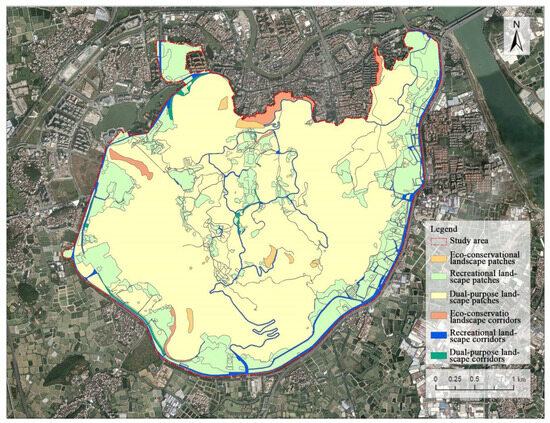
Figure A1.
Landscape map based on the secondary functional classification.

Figure A2.
Landscape map based on the tertiary functional classification.
References
- Wang, R.; Liu, J.M.; Chen, T.; Tian, D.J. Distribution of recreational area in suburban metropolis: A case study of Beijing. Acta Geogr. Sin. 2010, 65, 745–754. [Google Scholar] [CrossRef]
- Liu, Y.S.; Li, J.T.; Yang, Y.Y. Strategic adjustment of land use policy under the economic transformation. Land Use Policy 2018, 74, 5–14. [Google Scholar] [CrossRef]
- Liu, Y.S.; Zhang, Z.W.; Zhou, Y. Efficiency of construction land allocation in China: An econometric analysis of panel data. Land Use Policy 2018, 74, 261–272. [Google Scholar] [CrossRef]
- Yang, C.G.; Guo, J.Y.; Li, Z.L. Planning of recreation tourism in suburb forest parks—A case study of Niushou Mountain in Nanjing. J. Northwest For. Univ. 2013, 28, 233–237. [Google Scholar] [CrossRef]
- Liu, Y.P.; Hu, M.J.; Zhao, B. Interactions between forest landscape elements and eye movement behavior under audio-visual integrated conditions. J. For. Res. 2020, 25, 21–30. [Google Scholar] [CrossRef]
- Frondoni, R.; Mollo, B.; Capotorti, G. A landscape analysis of land cover change in the municipality of Rome (Italy): Spatio-temporal characteristics and ecological implications of land cover transitions from 1954 to 2001. Landsc. Urban Plan. 2011, 100, 117–128. [Google Scholar] [CrossRef]
- Leopold, A. A Sand County Almanac: With Other Essays on Conservation from Round River; Oxford University Press: New York, NY, USA, 1966. [Google Scholar]
- Mageau, M.T.; Costanza, R.; Ulanowicz, R.E. The development and initial testing of a quantitative assessment of ecosystem health. Ecosyst. Health 1995, 1, 201–213. [Google Scholar]
- Rapport, D.J.; Gaudett, C.; Karr, J.R.; Baron, J.S.; Bohlen, C.; Jackson, W.; Jones, B.; Naiman, R.J.; Norton, B.; Pollock, M.M. Evaluating landscape health. J. Environ. Manage. 1998, 53, 1–15. [Google Scholar] [CrossRef]
- Zhao, Q.; Tang, H.H.; Gao, C.J.; Wei, Y.H. Evaluation of urban forest landscape health: A case study of the Nanguo Peach Garden, China. iForest-Biogeosci. For. 2020, 13, 175–184. [Google Scholar] [CrossRef]
- Shu, H.; Xiao, C.W.; Ma, T.; Sang, W.G. Ecological health assessment of Chinese National Parks based on landscape pattern: A case study in Shennongjia National Park. Int. J. Environ. Res. Public Health 2021, 18, 11487. [Google Scholar] [CrossRef]
- Wang, H.; Hou, P.; Jiang, J.B.; Xiao, R.L.; Zhai, J.; Fu, Z.; Hou, J. Ecosystem health assessment of Shennongjia National Park, China. Sustainability 2020, 12, 7672. [Google Scholar] [CrossRef]
- Wajchman-Świtalska, S.; Zajadacz, A.; Woźniak, M.; Jaszczak, R.; Beker, C. Recreational evaluation of forests in urban environments: Methodological and practical aspects. Sustainability 2022, 14, 15177. [Google Scholar] [CrossRef]
- Levandovská, N.; Šerá, B.; Žarnovičan, H.; Akbar, K.F. Determination of recreation potential in three urban forests. Sylwan 2021, 165, 627–638. [Google Scholar] [CrossRef]
- Fang, X.S.; Liu, S.; Chen, W.Z.; Wu, R.Z. An effective method for wetland park health assessment: A case study of the Guangdong Xinhui National Wetland Park in the Pearl River Delta, China. Wetlands 2021, 41, 44. [Google Scholar] [CrossRef]
- García-Ayllón, S.; Martínez, G. Analysis of correlation between anthropization phenomena and landscape values of the territory: A GIS framework based on spatial statistics. ISPRS Int. J. Geo-Inf. 2023, 12, 323. [Google Scholar] [CrossRef]
- Schüpbach, B.; Kay, S. Validation of a visual landscape quality indicator for agrarian landscapes using public participatory GIS data. Landsc. Urban Plan. 2024, 241, 104906. [Google Scholar] [CrossRef]
- Das, M.; Das, A.; Mandal, A. Research note: Ecosystem Health (EH) assessment of a rapidly urbanizing metropolitan city region of eastern India—A study on Kolkata Metropolitan Area. Landsc. Urban Plan. 2020, 204, 103938. [Google Scholar] [CrossRef]
- Das, S.; Pradhan, B.; Shit, P.K.; Alamri, A.M. Assessment of wetland ecosystem health using the pressure–state–response (PSR) model: A case study of Mursidabad District of West Bengal (India). Sustainability 2020, 12, 5932. [Google Scholar] [CrossRef]
- Li, Y.F.; Dong, L. Assessment and forecast of Beijing and Shanghai’s urban ecosystem health. Sci. Total Environ. 2014, 487, 154–163. [Google Scholar] [CrossRef]
- Tehrani, N.A.; Shafri, H.Z.M.; Salehi, S.; Chanussot, J.; Janalipour, M. Remotely-Sensed Ecosystem Health Assessment (RSEHA) model for assessing the changes of ecosystem health of Lake Urmia Basin. Int. J. Image Data Fusion 2022, 13, 180–205. [Google Scholar] [CrossRef]
- Peng, J.; Liu, Y.X.; Wu, J.S.; Lv, H.L.; Hu, X.X. Linking ecosystem services and landscape patterns to assess urban ecosystem health: A case study in Shenzhen City, China. Landsc. Urban Plan. 2015, 143, 56–68. [Google Scholar] [CrossRef]
- Haase, R.; Nolte, U. The invertebrate species index (ISI) for streams in southeast Queensland, Australia. Ecol. Indic. 2008, 8, 599–613. [Google Scholar] [CrossRef]
- De Toro, P.; Iodice, S. Ecosystem health assessment in urban contexts: A proposal for the Metropolitan Area of Naples (Italy). Aestimum 2018, 72, 39–59. [Google Scholar]
- Ma, Z.L.; Chen, L.H.; Han, P.; Yu, X.W.; Nie, S. Study on health assessment of scenic forest in Jiufeng National Forest Park. Res. Soil Water Conserv. 2010, 17, 207–211. [Google Scholar]
- Wang, J.W.; Zhang, J.H.; Wang, P.J.; Ma, X.B.; Yang, L.J.; Zhou, L.Y. Progress in ecosystem health research and future prospects. Sustainability 2022, 14, 15814. [Google Scholar] [CrossRef]
- Han, X.; Hu, J.L.; Liu, C.S.; Wang, X.Y. Mountain landscape health diagnosis and pattern evolution based on remote sensing: Case study in Xinjiang Tianshan Karajun-Kurdening. Acta Ecol. Sin. 2021, 41, 6451–6465. [Google Scholar] [CrossRef]
- Chen, M.T.; Zhou, J.Y.; Bao, Z.T.; Hua, G.D.; Li, J.L. Study on risk assessment of provincial wetland degradation—Based on multi-scale analysis of geographical grids and landscape character units. Chin. Landsc. Archit. 2023, 39, 52–58. [Google Scholar] [CrossRef]
- Wang, F.; Ye, C.S.; Hua, J.Q.; Li, X. Coupling relationship between urban spatial expansion and landscape ecological risk in Nanchang City. Acta Ecol. Sin. 2019, 39, 1248–1262. [Google Scholar] [CrossRef]
- Wang, Y.S.; Tang, D.; Yan, X.D.; Li, S.X.; Yu, Z.X.; Wu, L. Research on ecological security evaluation of Central Baoshan City based on grid scale. J. Southwest For. Univ. 2021, 41, 80–87. [Google Scholar]
- Zuo, Q.; Zhou, Y.; Li, Q.; Wang, L.; Liu, J.Y.; He, N. Spatial and temporal variations of landscape ecological risk in the mountainous region of southwestern Hubei Province based on the optimal scale. Chin. J. Ecol. 2023, 42, 1186–1196. [Google Scholar] [CrossRef]
- Li, Y.F.; Liu, H.Y.; Cao, X.; Zheng, N. Spatial differences of landscape health in urban wetland parks: A case study of Xixi Wetland Park in Hangzhou. Acta Geogr. Sin. 2010, 65, 1429–1437. [Google Scholar] [CrossRef]
- Wiens, J.A. Landscape ecology: The science and the action. Landsc. Ecol. 1999, 14, 103. [Google Scholar] [CrossRef]
- Li, Y.F.; Liu, H.Y.; Zhang, H.B.; Sun, Y.M.; Li, Y.L. The study of landscape health based on landscape structure and water environment: A case study of Xixi Wetland Park in Hangzhou. J. Nat. Resour. 2015, 30, 761–771. [Google Scholar] [CrossRef]
- Yang, Y.H. Elements of information theory. J. Am. Stat. Assoc. 2008, 103, 429. [Google Scholar] [CrossRef]
- Ogwang, T.; Cho, D.I. Olympic rankings based on objective weighting schemes. J. Appl. Stat. 2021, 48, 573–582. [Google Scholar] [CrossRef] [PubMed]
- Liu, H.Y.; Liu, Y.C.; Meng, L.H.; Jiao, K.Q.; Zhu, M.Y.; Chen, Y.K.; Zhang, P.F. Research progress of entropy weight method in water resources and water environment. J. Glaciol. Geocryol. 2022, 44, 299–306. [Google Scholar] [CrossRef]
- Navalho, I.; Alegria, C.; Roque, N.; Quinta-Nova, L. Mapping forest landscape multifunctionality using multicriteria spatial analysis. Floresta Ambiente 2019, 26, e20170702. [Google Scholar] [CrossRef]
- Liu, H.Y.; Li, Z.F.; Li, Y.F.; Lin, Z.S. Evaluation of sustainable capacity of national wetland park ecological analysis based on constraint and support function. Resour. Sci. 2015, 37, 805–814. [Google Scholar]
- Chen, W.Y.; Li, X. Urban forests’ recreation and habitat potentials in China: A nationwide synthesis. Urban For. Urban Green. 2021, 66, 127376. [Google Scholar] [CrossRef]
- Masek, J.G.; Hayes, D.J.; Hughes, M.J.; Healey, S.P.; Turner, D.P. The role of remote sensing in process-scaling studies of managed forest ecosystems. For. Ecol. Manag. 2015, 355, 109–123. [Google Scholar] [CrossRef]
- Johnston, D.; Lowell, K. Forest volume relative to cartographic boundaries and sample spacing, unit size and type. Geogr. Environ. Modell. 2000, 4, 105–120. [Google Scholar] [CrossRef]
- Gupta, K.; Kumar, P.; Pathan, S.K.; Sharma, K.P. Urban neighborhood green index—A measure of green spaces in urban areas. Landsc. Urban Plan. 2012, 105, 325–335. [Google Scholar] [CrossRef]
- Chmiel, J. Cultural landscape as both a threat and an opportunity to preserve a high conservation value of vascular flora: A case study. Diversity 2023, 15, 211. [Google Scholar] [CrossRef]
- Hao, Z.Z.; Wang, C.; Sun, Z.K.; van den Bosch, C.K.; Zhao, D.X.; Sun, B.Q.; Xu, X.H.; Bian, Q.; Bai, Z.T.; Wei, K.Y.; et al. Soundscape mapping for spatial-temporal estimate on bird activities in urban forests. Urban For. Urban Green. 2021, 57, 126822. [Google Scholar] [CrossRef]
- Gioia, A.; Paolini, L.; Malizia, A.; Oltra-Carrió, R.; Sobrino, J.A. Size matters: Vegetation patch size and surface temperature relationship in foothills cities of northwestern Argentina. Urban Ecosyst. 2014, 17, 1161–1174. [Google Scholar] [CrossRef]
- Maseko, M.S.T.; Zungu, M.M.; Ehlers Smith, D.A.; Ehlers Smith, Y.C.; Downs, C.T. Effects of habitat-patch size and patch isolation on the diversity of forest birds in the urban-forest mosaic of Durban, South Africa. Urban Ecosyst. 2020, 23, 533–542. [Google Scholar] [CrossRef]
- Gratzfeld, J.; Wen, X.Y.; Jones, M.; Rivers, M. Safeguarding China’s native trees—A review of integrated conservation practices between 2008 and 2020. Glob. Ecol. Conserv. 2022, 35, e02101. [Google Scholar] [CrossRef]
- Thomas, E.; Jalonen, R.; Loo, J.; Boshier, D.; Gallo, L.; Cavers, S.; Bordács, S.; Smith, P.; Bozzano, M. Genetic considerations in ecosystem restoration using native tree species. For. Ecol. Manag. 2014, 333, 66–75. [Google Scholar] [CrossRef]
- He, J.H.; Pan, Z.Z.; Liu, D.F.; Guo, X.N. Exploring the regional differences of ecosystem health and its driving factors in China. Sci. Total Environ. 2019, 673, 553–564. [Google Scholar] [CrossRef]
- Cao, Y.; Xiao, D.N.; Ou, Y.H.; Chen, G. Analysis of landscape change drivers in the Ejina natural oasis. Acta Ecol. Sin. 2004, 24, 1895–1902. [Google Scholar]
- Klaus, V.H.; Kiehl, K. A conceptual framework for urban ecological restoration and rehabilitation. Basic Appl. Ecol. 2021, 52, 82–94. [Google Scholar] [CrossRef]
Disclaimer/Publisher’s Note: The statements, opinions and data contained in all publications are solely those of the individual author(s) and contributor(s) and not of MDPI and/or the editor(s). MDPI and/or the editor(s) disclaim responsibility for any injury to people or property resulting from any ideas, methods, instructions or products referred to in the content. |
© 2023 by the authors. Licensee MDPI, Basel, Switzerland. This article is an open access article distributed under the terms and conditions of the Creative Commons Attribution (CC BY) license (https://creativecommons.org/licenses/by/4.0/).